People in Trinidad routinely come into contact with several of our common birds but few actually take the time to learn more about them. The birds listed here are all well suited to life in residential and urban areas in addition to their natural habitat. Many are generalists, meaning that they can survive on a variety of foods (their diet) and live in a range of habitats, which allows them to thrive despite our modifications to the environment. This close association with humans has also led to these birds having common or vernacular names (NOTE: Tobago’s common birds will be treated with separately).
Great Kiskadee (Local names: Kiskadee)
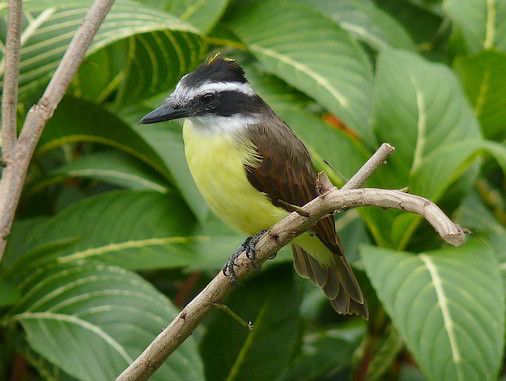
While it is probably the best known bird in Trinidad, it is perhaps surprising that the Kiskadee (Pitangus sulphuratus) is not normally found in Tobago. It is easily identified thanks to its black and white streaked face, bold yellow under-parts and brown back. They are also well known thanks to their loud vocalizations and fearless behaviour. The Kiskadee’s diet is extremely varied and includes large insects, fish, small reptiles, fruit and cooked foods. They are not fond of mangoes but will readily accept ripe bananas at birdfeeders. Additionally they are very aggressive and these two factors (diet and behaviour) are largely responsible for their widespread distribution in cultivated lands and residential areas. They are less common in heavily forested areas.
Tropical Kingbird
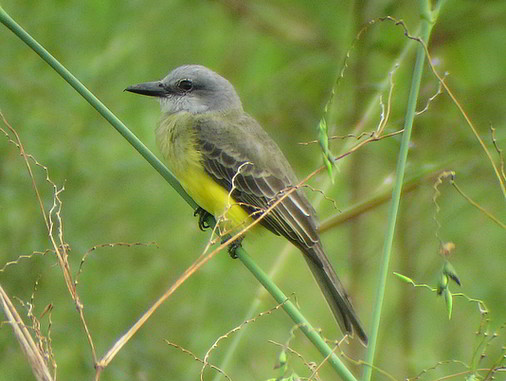
Often mistaken for a Kiskadee because of its yellow belly, the Tropical Kingbird (Tyrannus melancholicus) can easily be distinguished by the lack of black and white facial markings as found on the Kiskadee. Primarily an insect eater, it is often seen perched on suitable vantage points (like electricity wires or branches) from which it chases after flying insects. They regularly chase after and attack hawks and other large birds which wander too close to its territory. Its call is an excited trill, usually accompanied by rapid wing flapping
Blue-grey Tanager and Palm Tanager (Local names: Blue Jean and Palmiste)
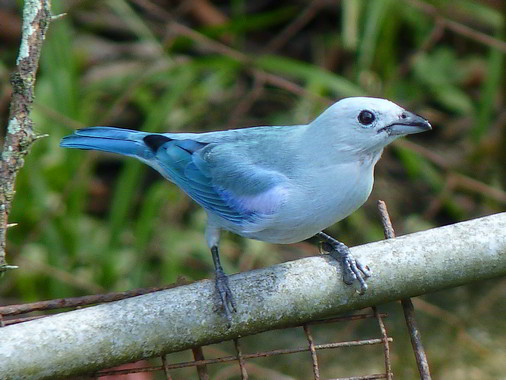
Both of these tanagers (tan-a-jers) are very closely related and shall be dealt with as a group. The Blue-grey Tanager (Thraupis episcopus) or Blue Jean is a lovely shade of light blue with darker blue wings. There is a patch of violet on the wing which is visible when seen in good light conditions.
The other tanager is the Palm Tanager (Thraupis palmarum) or Palmiste.
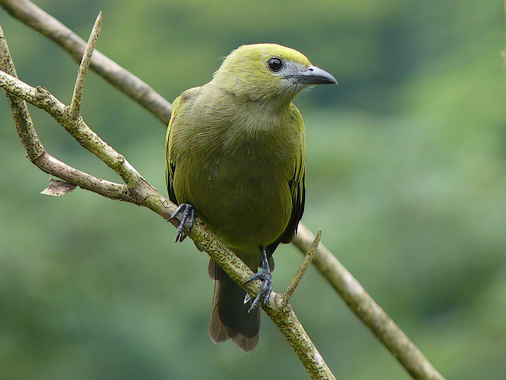
This bird is a combination of different shades of olive/dark green, very beautiful on its own when viewed up close. The name of ‘Palmiste’ comes from their habit of frequenting palm trees as they search for insects. It is also often seen around houses as they favour nesting under roof eaves. Both birds have similar diets of fruit and some insects and are found in forests, swamp and scrubland. They also have identical voices consisting of a series of twittering and chirps and live in identical habitats. So similar are the two that the birds may sometimes hybridize. They will accept any ripe soft fruit.
Silver-beaked Tanager (Local name : Silver beak)
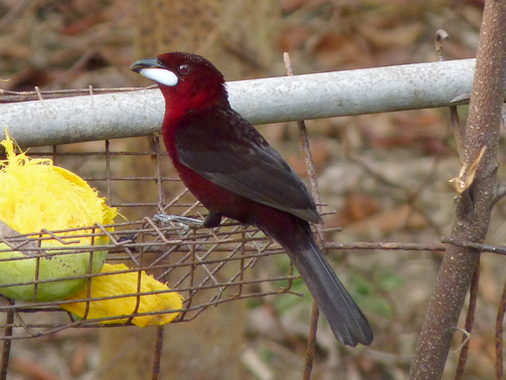
A common tanager in Trinidad (but not found in Tobago) is the beautiful Silver-beaked Tanager. Male birds are crimson red with a large pale blue lower beak which gives it its name. Female birds lack the flashy bill and have drab red plumage. They have a very sharp metallic call, quite unlike the calls of the other common tanager species. Like other garden tanagers, they are very fond of ripe fruit and will readily come to bird feeders. Unlike the next species, the Silver-beaked Tanager seems to prefer a fair amount of vegetation and is less likely to be seen in urban areas.
White-lined Tanager (Local name: Parson)
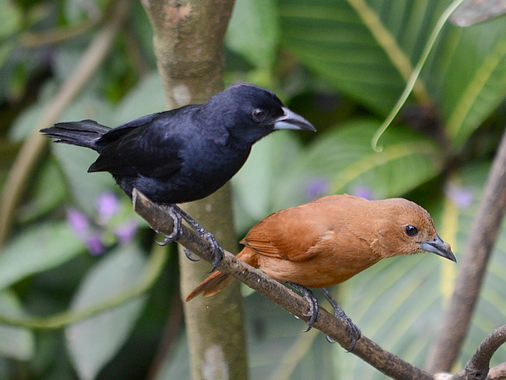
The white lined tanager is a common garden and forest inhabitant. Males are black with the exception of a small patch of white feathers under the wing which is visible in brief flashes as the bird flies or flicks its wing. Females are brown and lack the white patch. This species can be found in a variety of habitats ranging from very urbanized environments to forests and are readily attracted to ripe fruit.
Tropical Mockingbird (Local name: Day clean)
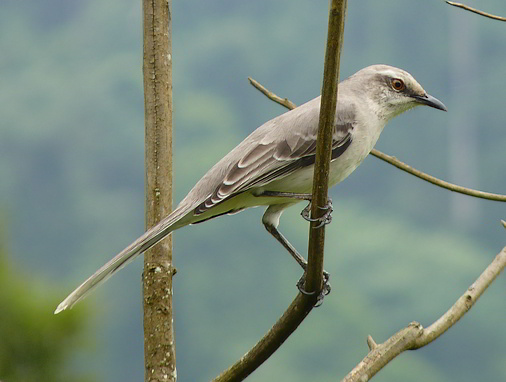
The Tropical Mockingbird (Mimus gilvus) is a relatively recent arrival to Trinidad and Tobago. It was first seen in the early 1900’s in north Trinidad but has since spread throughout the island. It is grey in colour and is often seen running along the ground where it regularly stops and briefly spreads its wings. It has been suggested that this flashing helps to flush its insects prey. They also feed on fruit and will accept ripe bananas at birdfeeders. They are very aggressive.
Bananaquit (Local name: Sucrier (often mispronounced as sik-ee-aye))
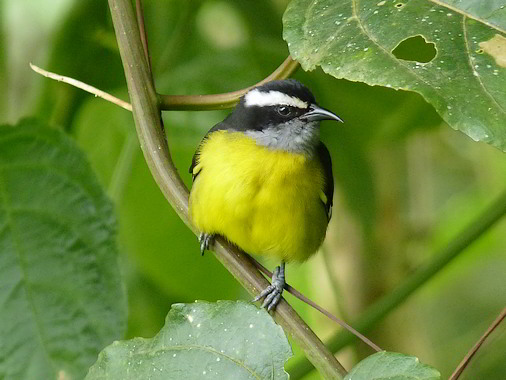
The Bananaquit (Coereba flaveola) is an active little bird, frequently seen amongst flowers in a garden feeding on nectar. Because they have short bills they will often resort to piercing the base of flowers to access their otherwise unreachable nectaries. They have yellow undersides, a black back and a gray throat. Like some other birds, Bananaquits that live at higher altitudes are more brightly coloured than their lowland kin. Their call is a musical warble and there is much variation between the sounds of birds from different areas of the country. They are known to build a second nest for sleeping. Bananaquits will come to feed on any ripe fruit, sugar or even a shallow bowl of water to bathe in.
Yellow Oriole (Local name: Plantain bird)
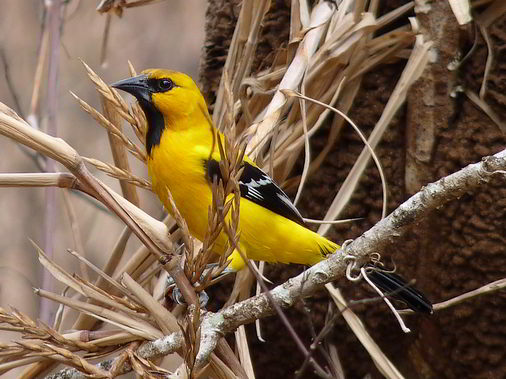
The yellow oriole (Icterus nigrogularis) is handsome golden-yellow and black bird that is hard to miss. They feed on a range of soft fruits, insects and kitchen scraps (I have even seen a pair eating leftovers from a discarded KFC box) and are very fond of over-ripe bananas and mangoes at the birdfeeder. They inhabit a range of environments and like to build their hanging nests near water.
Carib Grackle (Local names: Blackbird or Boat-tail)
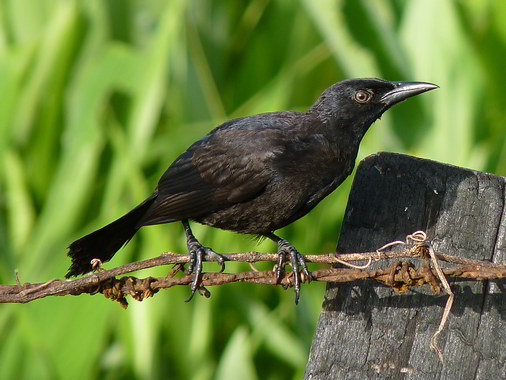
The well known Blackbird (Quiscalus lugubris) is often seen in small groups feeding near houses where they eat household scraps or feed on insects. The males are glossy black while females are a duller brown. In courtship, males raise their tails and sing, trying to attract the attention of a female. Their other local name of “Boat tail” comes from their habit of holding their tail in a deep “V” shape, when flying. Bread or rice will attract them.
Shiny Cowbird (Local name: no widely popular name but sometimes called Lazy bird or Singing Angel)
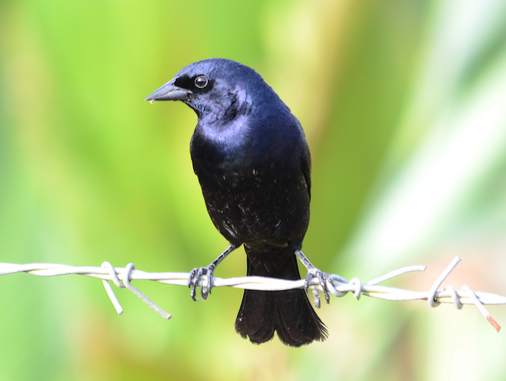
The Shiny Cowbird can be confused with a Carib Grackle but can be differentiated by its shiny iridescent feathers and dark iris (Compared to the white iris in a Grackle). It is also a much more streamlined bird in comparison to a Grackle. Male Shiny Cowbirds have a beautiful bubbling song which has given rise to one of their local names – “singing angel”. Shiny Cowbirds are brood parasites. They will lay their eggs in the nest of other birds, often House Wrens, and leave the care of the egg and chick to the surrogate parents (hence the other local name – Lazybird). Usually, the young Cowbird will get rid of other chicks or eggs in the nest by pushing them out. This way the young Shiny Cowbird reduces competition for food. It is not uncommon to see a House Wren feeding a begging Shiny Cowbird chick more than twice its size.
Spectacled Thrush – formerly Bare-eyed Thrush (Local names: Big eye grieve)
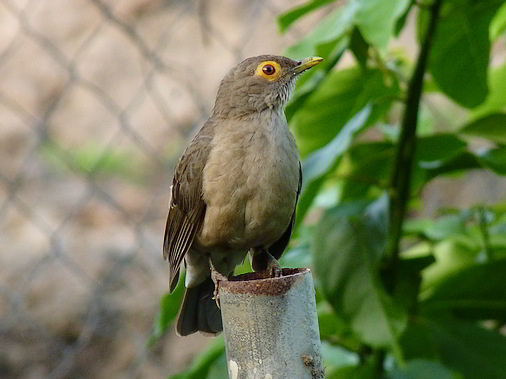
The Spectacled Trush (Turdus nudigenis) is a drab brown bird with a bright orange eye-ring. Individual birds have a lot of character and can become rather tame. A bird in my yard would religiously bathe every evening before going to its nest. They are quite interesting to observe and are often seen feeding on soft dirt where they hop about and then suddenly dive to the ground, usually emerging with an earthworm. They have a cat like call, often made in the late evening from a favourite perch. Will take fruit from feeders.
House Wren (Local names: House Bird or God Bird)
House Wren (Troglodytes musculus)
The House Wren (Troglodytes musculus) gets its name from its habit of nesting in buildngs. It is also known by the local name of “God bird” by some because it may be seen in old churches. An insect eater, it dutifully searches gardens and fields for food, often in pairs, with the two birds calling regularly to maintain contact. Its nest is frequently parasitized by the Shiny Cowbird and it is not uncommon for one to see a house wren feeding a much larger cowbird fledgling. Its call is a lovely musical warble.
Ruddy Ground-Dove (Columbina talpacoti)
This is the common brown dove often seen nervously feeding on the ground. Males have a rich reddish brown colour with a lighter grey head. The smaller females are duller in colour. Birds commonly fall prey to cats and other predators while on the ground and when not feeding may often perch in small trees and call. Their voice is a soft cooing. Ruddy Ground-Doves (Columbina talpacoti) build very fragile nests in dense vegetation throughout the year. They may visit birdfeeders to feed on grains and bread.
Smooth-billed Ani (Local names: Merle Corbeau)
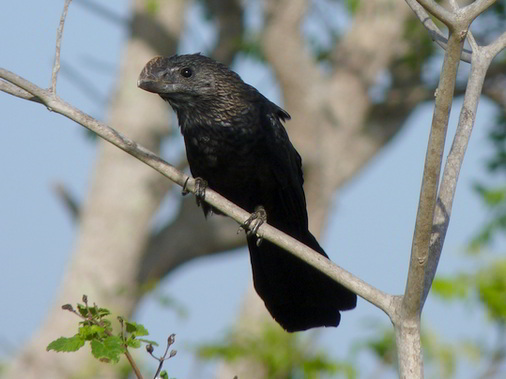
While they are locally know as “Merle Corbeau”, these birds have no relation to the New World Vultures and are in fact a member if the New World Cuckoo family. Smooth-billed Anis (Crotophaga ani) are black birds are almost always found in groups and these family birds even nest in a single large communal nest. Their most striking feature is the unusual raised keel of their bills as well as a “mew”ing call. Feeding on insects and other invertebrates the feeding groups will slowly work their way through the vegetation searching for prey.
Yellow-bellied Elaenia (Local name: Top-knot)
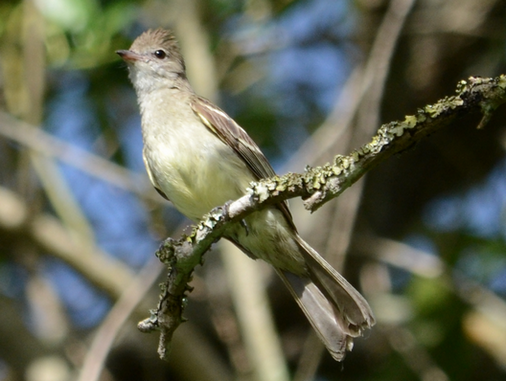
This excitable flycatcher is best identified by its call, which can be likened to a musical wheezing. Other key features include a bushy crest, which is often erect, yellow-olive under-parts and olive brown upper-parts. This bird has a dirtier appearance when compared to the next species. They are usually found in pairs or small family groups. The “Top-knot” is noticeably larger than the other local elaenias which, together with the feature noted above, should help in identification. Elaenias feed primarily on insects but will occasionally take fruit in the form of small berries.
Grayish Saltator (Local name: Pitch-oil)
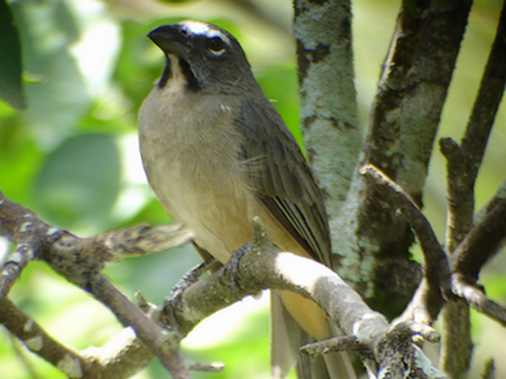
The “Pitch Oil” is unusual among our local garden birds. While it will eat fruit, its diet also includes leaves and it can often be seen feeding on overgrown fence lines or vegetable gardens (they are fond of bodi leaves). Adult birds are grayish brown with a white streak above the eye while younger birds are mossy green. The local name is derived from their call which almost sounds like it is saying “pitch-oil”. This charming bird is not found in Tobago.
Yellow Warbler (Local name: none)
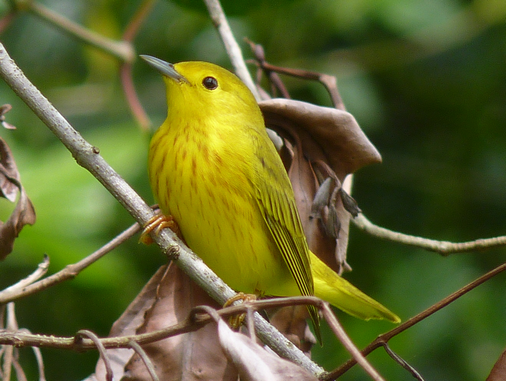
The Yellow Warbler is our most common migrant warbler, appearing in great numbers between September and March before returning to their breeding grounds in North America. They inhabit a wide variety of habitats from home gardens to mangrove swamps to rain-forests where they search for their insect prey. Yellow Warblers rarely, if ever, sing while in Trinidad and Tobago. They do call occasionally while feeding, uttering a single “chip” note. Both sexes are yellow in colour with dirty yellow wings. Additionally, male birds may have dark reddish streaks on their chests.
Saffron Finch(Local name: none)
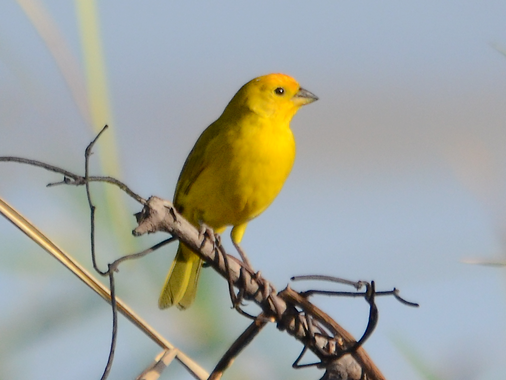
The Saffron Finch is an attractive yellow bird with an orange forehead. Because of its preference for open areas and pastures it has readily adapted to urban gardens where well kept lawns provide an attractive substitute – so much so that nowadays they are found almost exclusively around houses (one wonders where they lived before human settlements developed on the island). Despite their resemblance to other local seedeaters (to whom they are not directly related), Saffron Finches have never been popular targets for the cage-bird trade thanks largely to their relatively poor singing abilities.
Ferruginous Pygmy-Owl (Local name: Jumbie bird)
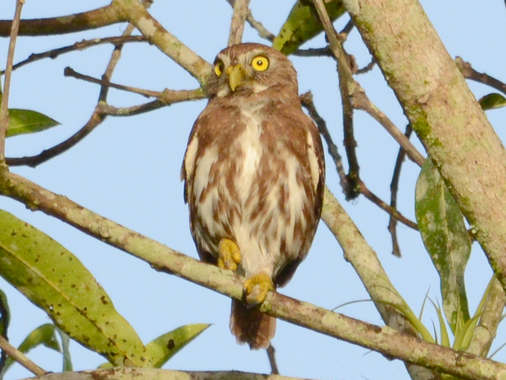
This small owl is the familiar “Jumbie Bird” of local and regional folklore. It is perceived as an omen of death and to have one calling near a house was seen as a sure sign that someone would soon die. The owl is, of course, completely harmless. It usually feeds at night but it is possible to find birds active in the late afternoon when it hunts for its typical prey – insects. They are found in a wide range of habitats, from deep forests to urban environments (even the Brian Lara Promenade). Pygmy-Owls are well known to bird-watchers in Trinidad who imitate the owl’s simple repeating “who-who-who” call in order to attract small birds which quickly congregate to chase the ‘owl’ away.
